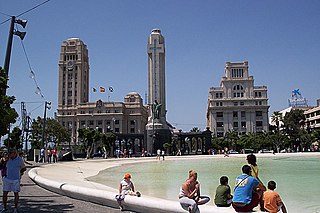
Santa Cruz de Tenerife, commonly abbreviated as Santa Cruz, is a city, the capital of the island of Tenerife, Province of Santa Cruz de Tenerife, and one of the capitals of the Canary Islands, along with Las Palmas. Santa Cruz has a population of 206,593 (2013) within its administrative limits. The urban zone of Santa Cruz extends beyond the city limits with a population of 507,306 and 538,000 within urban area. It is the second largest city in the Canary Islands and the main city on the island of Tenerife, with nearly half of the island's population living in or around it.
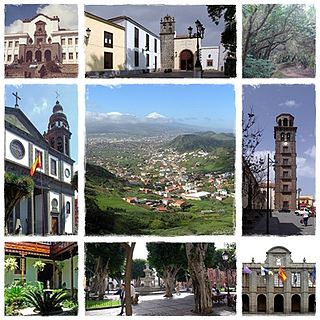
San Cristóbal de La Laguna is a city and municipality in the northern part of the island of Tenerife in the Province of Santa Cruz de Tenerife, on the Canary Islands, Spain. The former capital of the Canary Islands, the city is the third-most populous city of the archipelago and the second-most populous city of the island. La Laguna's historical center was declared a World Heritage Site by UNESCO in 1999. La Laguna is situated alongside the city of Santa Cruz de Tenerife; thus, the two cities and municipalities form a single large urban center. Its economy is business-oriented while agriculture dominates the northeastern portion of the city. The urban area dominates the central and the southern parts.
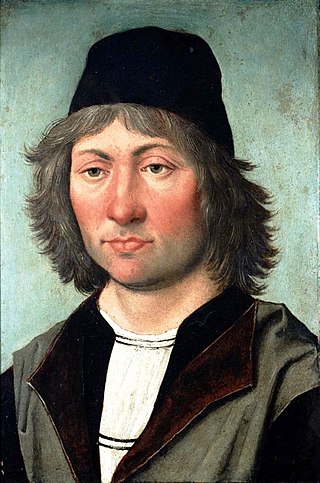
Pedro Berruguete was a Spanish painter whose art is regarded as a transitional style between Gothic and Renaissance art. Berruguete most famously created paintings of the first few years of the Inquisition and of religious imagery for Castilian retablos. He is considered by some as the first Renaissance painter in Spain.

Bartolomé Bermejo was a Spanish painter who adopted Flemish painting techniques and conventions. Born in Cordoba, he is known for his work in the Crown of Aragon, including the Principality of Catalonia and the Kingdom of Valencia. His real name was Bartolomé de Cárdenas: the name Bermejo, which means auburn in Spanish, possibly relates to his hair colour. Bermejo may relate also to his name, Cardenas; Cardeno means purplish.

Rafael Tegeo Díaz was a Spanish Neoclassical painter, known primarily for his portraits. His name is sometimes spelled Tejeo.

Evaristo Muñoz Estarlich was a Spanish Baroque painter; a follower of the decorative style introduced to Valencia by Antonio Palomino. Some sources give his year of birth as 1671.

Jan de Beer, formerly known as the Master of the Milan Adoration was a Flemish painter, draughtsman and glass designer active in Antwerp at the beginning of the 16th century. He is considered one of the most important members of the loose group of painters active in and around Antwerp in the early 16th century referred to as the Antwerp Mannerists. Highly respected in his time, he operated a large workshop with an important output of religious compositions.
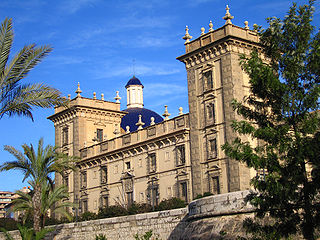
The Museu de Belles Arts de València is an art gallery in Valencia, Spain, founded in 1913. It houses some 2,000 works, most dating from the 14th–17th centuries, including a Self portrait of Diego Velázquez, a St. John the Baptist by El Greco, Goya's Playing Children, Gonzalo Pérez's Altarpiece of Sts. Ursula, Martin and Antony and a Madonna with Writing Child and Bishop by the Italian Renaissance master Pinturicchio. It houses a large series of engravings by Giovan Battista Piranesi.

The Archbishop's Palace of Seville is a palace in Seville, Spain. It has served as the residence of bishops and archbishops of the episcopal sees and numerous nobleman and military figures to the present time. It is located in the southern section of Seville, in the Plaza Virgen de los Reyes, angled almost opposite the Giralda. It is situated on the northeastern side of Seville Cathedral in the neighborhood of Santa Cruz. Of Spanish Baroque architectural style, it has had the status of National Monument since 1969.
Antonio Rodríguez Luna was a Spanish painter who developed most of his career while in exile in Mexico during the Spanish Civil War. He began his career young, while still studying in Madrid and before the war had already exhibited in various places in Europe. His opposition to Francisco Franco, forced him into exile, with intellectuals and artists in the country arranging his asylum. His career here included a Guggenheim Fellowship with major exhibitions in Washington DC and New York along with exhibitions at the Museo de Arte Moderno and the Palacio de Bellas Artes in Mexico. Despite his success, he never forgot his Spanish roots, with an exhibition in Madrid in 1971 and a return to his hometown of Montoro in 1981, after the death of Franco.

The Museo Municipal de Bellas Artes de Santa Cruz de Tenerife is a museum of fine arts located in the city of Santa Cruz de Tenerife. Its headquarters are located in the rear of the Church of St. Francis of Assisi.

The Museum of Santa Cruz is an art, archaeology and ethnographic museum located in the historic centre of the city of Toledo, Spain. It exhibits collections pertaining to the province of Toledo, including works painted by El Greco in the city of Toledo.
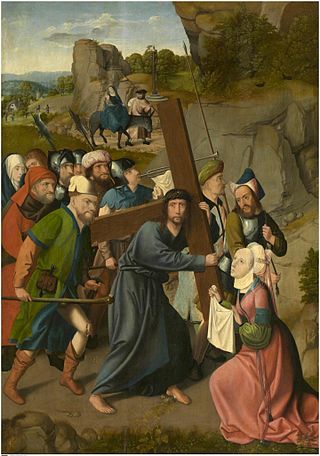
The Master of Hoogstraeten is the Notname given to a Flemish painter or a collective of painters active in Antwerp in the early 16th century. The master created principally religious paintings and is considered a member of the Antwerp Mannerists.

José Aguiar or José Aguiar García was a painter and muralist from La Gomera.

The Master with the Parrot or Master of the Parrot is the notname given to a group of Flemish painters who likely worked in a workshop in Antwerp in the first half of the 16th century. They produced devotional pictures for the local bourgeoisie in a style reminiscent of contemporary Flemish painters working in an Italianate style.
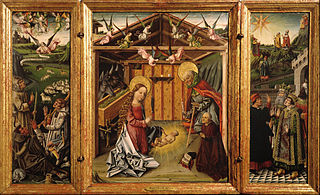
The Master of Ávila, a painter in the Flemish style of Fernando Gallego, was active in Ávila and surroundings in the middle of the 15th century. The art historian Elías Tormo and others have tentatively identified him as García del Barco, a painter who was known to have been in Ávila between 1465 and 1473. No works by Barco have been attributed with any certainty.
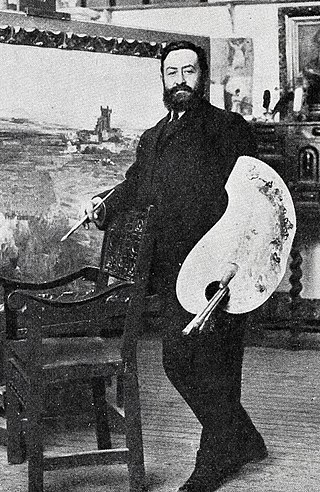
Marceliano Santa María was a Spanish painter, noted for his Castilian landscapes, historical art, and portraits.








